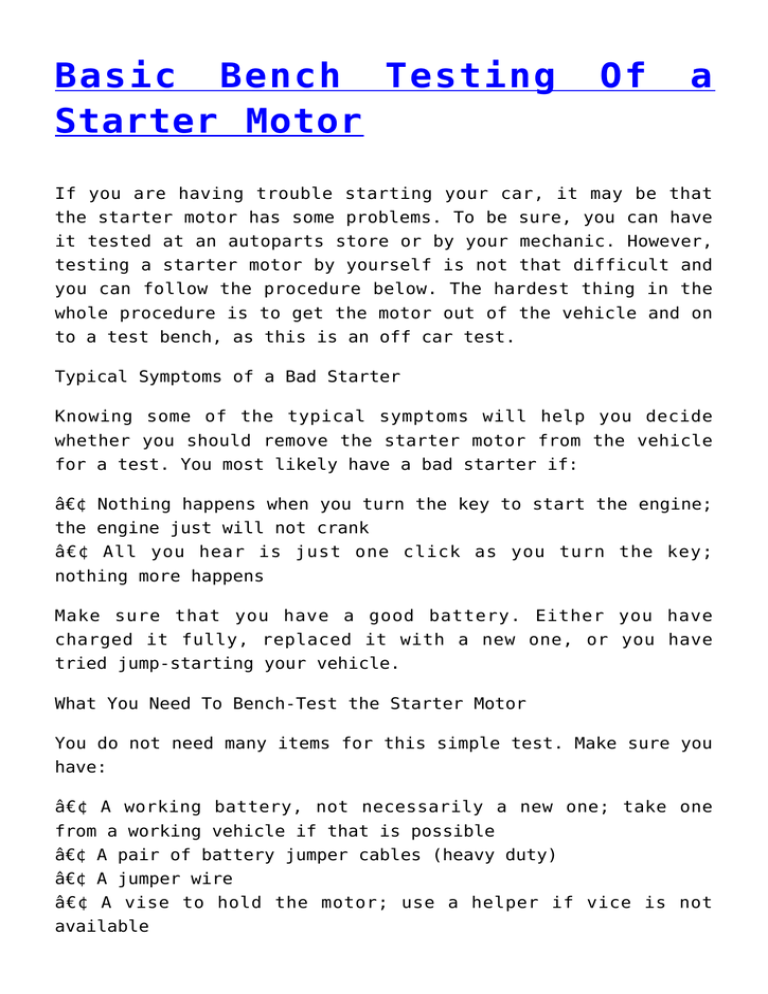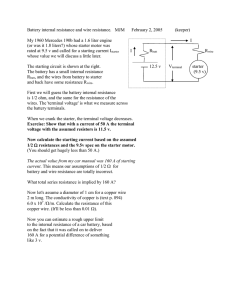Bench Testing Starter Motors: A Step-by-Step Guide
advertisement

Basic Bench Testing Starter Motor Of a If you are having trouble starting your car, it may be that the starter motor has some problems. To be sure, you can have it tested at an autoparts store or by your mechanic. However, testing a starter motor by yourself is not that difficult and you can follow the procedure below. The hardest thing in the whole procedure is to get the motor out of the vehicle and on to a test bench, as this is an off car test. Typical Symptoms of a Bad Starter Knowing some of the typical symptoms will help you decide whether you should remove the starter motor from the vehicle for a test. You most likely have a bad starter if: • Nothing happens when you turn the key to start the engine; the engine just will not crank • All you hear is just one click as you turn the key; nothing more happens Make sure that you have a good battery. Either you have charged it fully, replaced it with a new one, or you have tried jump-starting your vehicle. What You Need To Bench-Test the Starter Motor You do not need many items for this simple test. Make sure you have: • A working battery, not necessarily a new one; take one from a working vehicle if that is possible • A pair of battery jumper cables (heavy duty) • A jumper wire • A vise to hold the motor; use a helper if vice is not available Be very careful to not let your fingers, clothing, jewelry or anything loose, is caught in the spinning pinion gear of the motor. How To Bench-Test the Starter Motor The starter bench test is applicable to almost all types of cars or trucks – whether it is Nissan, a Chevrolet, a Ford, a Toyota or whatever. In the adjoining photo, the numbers refer to: 1. Binding stud for attaching the starter/crank wire. When you turn the ignition key, this wire delivers the +12V for activating the starter solenoid and in turn makes the starter motor work. 2. Binding stud for attaching the jumper wire. 3. This is the grounding point; starter motors are typically grounded through their cases. Step 1: Hold the motor securely in a vice. Alternately, have a helper hold the motor the firmly. Be careful of the spinning pinion gear. Step 2: Attach the BLACK/BLUE wire of the battery jumper cable to the negative terminal of the battery. Attach the other end of this wire to the case (3) of the starter motor. Step 3: Attach the RED wire of the battery jumper cable to the positive terminal of the battery. Attach the other end of this wire to the binding stud (1) of the starter motor. Step 4: Attach one end of the jumper wire to the binding stud (2) of the starter motor. If a helper is holding the motor, this is the time to tell him to get ready to hold it firmly. When both are ready, touch the other end of the jumper wire to the binding stud (1) of the starter motor and hear/observe the results. Interpretation of the Results of the Test There are only three possible outcomes of this test and you will observe only one of them. Either the starter motor will rotate or it will not. If it rotates, it may rotate either very slowly or at its normal speed. Starter Motor Rotates at Normal Speed: This result tells you the starter motor is working perfectly well. The pinion gear comes out and spins fast and freely. Pinion Gear Comes Out But Rotates Very Slowly: This result tells you there is some problem with the starter motor. Starter Motor Makes Only A Click Sound And Nothing More Happens: This result tells you there is some problem with the starter motor. If the results point to a bad starter motor, it is advisable to recheck the condition of the battery you are using for the test. A weak or a dead battery will also give the same results that you would get for a bad starter motor. Therefore, it is prudent to identify if it is not the battery, before certifying the starter motor to be at fault.



